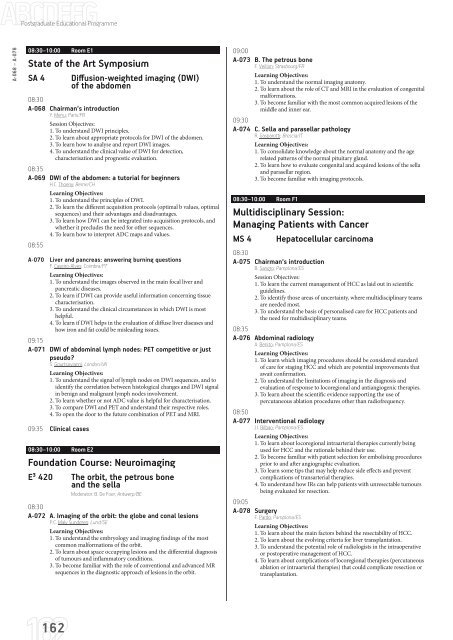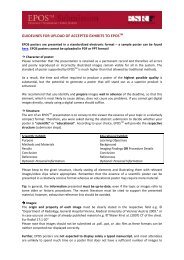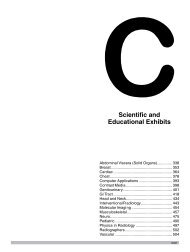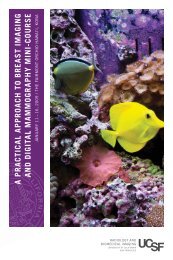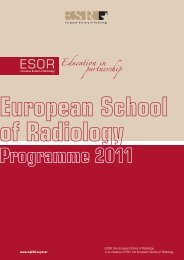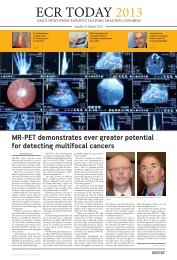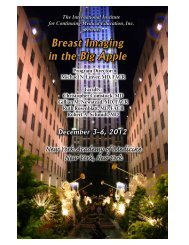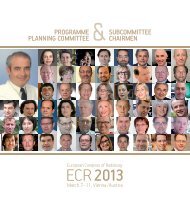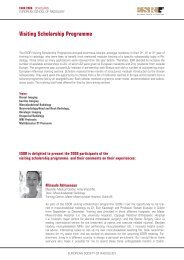ECR 2013 â Final Programme - myESR.org
ECR 2013 â Final Programme - myESR.org
ECR 2013 â Final Programme - myESR.org
- No tags were found...
You also want an ePaper? Increase the reach of your titles
YUMPU automatically turns print PDFs into web optimized ePapers that Google loves.
Postgraduate Educational <strong>Programme</strong>A-068 – A-07808:30–10:00 Room E1State of the Art SymposiumSA 4 Diffusion-weighted imaging (DWI)of the abdomen08:30A-068 Chairman‘s introductionY. Menu; Paris/FRSession Objectives:1. To understand DWI principles.2. To learn about appropriate protocols for DWI of the abdomen.3. To learn how to analyse and report DWI images.4. To understand the clinical value of DWI for detection,characterisation and prognostic evaluation.08:35A-069 DWI of the abdomen: a tutorial for beginnersH.C. Thoeny; Berne/CHLearning Objectives:1. To understand the principles of DWI.2. To learn the different acquisition protocols (optimal b values, optimalsequences) and their advantages and disadvantages.3. To learn how DWI can be integrated into acquisition protocols, andwhether it precludes the need for other sequences.4. To learn how to interpret ADC maps and values.08:55A-070 Liver and pancreas: answering burning questionsF. Caseiro-Alves; Coimbra/PTLearning Objectives:1. To understand the images observed in the main focal liver andpancreatic diseases.2. To learn if DWI can provide useful information concerning tissuecharacterisation.3. To understand the clinical circumstances in which DWI is mosthelpful.4. To learn if DWI helps in the evaluation of diffuse liver diseases andhow iron and fat could be misleading issues.09:15A-071 DWI of abdominal lymph nodes: PET competitive or justpseudo?S. Gourtsoyianni; London/UKLearning Objectives:1. To understand the signal of lymph nodes on DWI sequences, and toidentify the correlation between histological changes and DWI signalin benign and malignant lymph nodes involvement.2. To learn whether or not ADC value is helpful for characterisation.3. To compare DWI and PET and understand their respective roles.4. To open the door to the future combination of PET and MRI.09:35 Clinical cases08:30–10:00 Room E2Foundation Course: NeuroimagingE³ 420 The orbit, the petrous boneand the sellaModerator: B. De Foer; Antwerp/BE08:30A-072 A. Imaging of the orbit: the globe and conal lesionsP.C. Maly Sundgren; Lund/SELearning Objectives:1. To understand the embryology and imaging findings of the mostcommon malformations of the orbit.2. To learn about space occupying lesions and the differential diagnosisof tumours and inflammatory conditions.3. To become familiar with the role of conventional and advanced MRsequences in the diagnostic approach of lesions in the orbit.09:00A-073 B. The petrous boneF. Veillon; Strasbourg/FRLearning Objectives:1. To understand the normal imaging anatomy.2. To learn about the role of CT and MRI in the evaluation of congenitalmalformations.3. To become familiar with the most common acquired lesions of themiddle and inner ear.09:30A-074 C. Sella and parasellar pathologyR. Gasparotti; Brescia/ITLearning Objectives:1. To consolidate knowledge about the normal anatomy and the agerelated patterns of the normal pituitary gland.2. To learn how to evaluate congenital and acquired lesions of the sellaand parasellar region.3. To become familiar with imaging protocols.08:30–10:00 Room F1Multidisciplinary Session:Managing Patients with CancerMS 4 Hepatocellular carcinoma08:30A-075 Chairman‘s introductionB. Sangro; Pamplona/ESSession Objectives:1. To learn the current management of HCC as laid out in scientificguidelines.2. To identify those areas of uncertainty, where multidisciplinary teamsare needed most.3. To understand the basis of personalised care for HCC patients andthe need for multidisciplinary teams.08:35A-076 Abdominal radiologyA. Benito; Pamplona/ESLearning Objectives:1. To learn which imaging procedures should be considered standardof care for staging HCC and which are potential improvements thatawait confirmation.2. To understand the limitations of imaging in the diagnosis andevaluation of response to locoregional and antiangiogenic therapies.3. To learn about the scientific evidence supporting the use ofpercutaneous ablation procedures other than radiofrequency.08:50A-077 Interventional radiologyJ.I. Bilbao; Pamplona/ESLearning Objectives:1. To learn about locoregional intraarterial therapies currently beingused for HCC and the rationale behind their use.2. To become familiar with patient selection for embolising proceduresprior to and after angiographic evaluation.3. To learn some tips that may help reduce side effects and preventcomplications of transarterial therapies.4. To understand how IRs can help patients with unresectable tumoursbeing evaluated for resection.09:05A-078 SurgeryF. Pardo; Pamplona/ESLearning Objectives:1. To learn about the main factors behind the resectability of HCC.2. To learn about the evolving criteria for liver transplantation.3. To understand the potential role of radiologists in the intraoperativeor postoperative management of HCC.4. To learn about complications of locoregional therapies (percutaneousablation or intraarterial therapies) that could complicate resection ortransplantation.162


